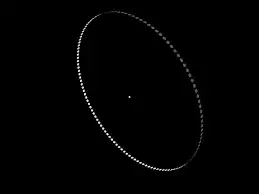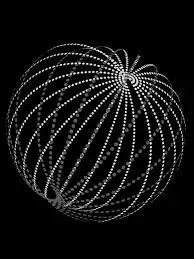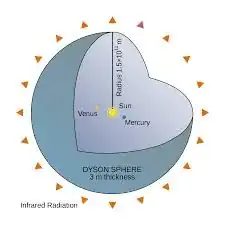In a type II civilization we may need to harvest the energy of neighboring stars. Freeman Dyson gave an interesting point of view that we could invent a megastructure to harvest this type of energy. In theory what are the possibilities of ways to construct a Dyson Sphere?
1 Answers
First, I'd like to point out that at this point the Dyson Sphere is purely theoretical in nature. Second, currently all plans to build a Dyson Sphere are, in the words of this website,
far beyond humanity's engineering capacity.
Portions of the technology involved in the Dyson Sphere have been developed, however, such as solar sails (a method of spacecraft propulsion that uses large mirrors driven by radiation pressure/solar wind from the sun) and orbiting satellites. These steps can be seen as the first small steps toward building a Dyson Sphere.
Variants on the Dyson Sphere
There are several concepts of the Dyson Sphere. The one closest to the original concept is called the Dyson Swarm. The Dyson Swarm is basically a bunch of solar powered satellites and/or space habitats orbiting in a dense formation around the star. The advantage of this idea is that it can be constructed incrementally. Various forms of wireless energy transfer could be used to get the energy back to Earth. The problem is that the orbits of the swarm would be incredibly complicated. The simplest orbit arrangement is the Dyson Ring, shown below:
The orbits, however, can be as complicated as the picture below, and even more complex:
Another conceptualization of the Dyson Sphere is the Dyson Shell, commonly depicted in science fiction. This would be a uniform solid shell of matter surrounding the star in question. This design would harness the full power of the Sun or any other star, but has several major theoretical difficulties, the such as that the Dyson Shell could be moved by objects such as comets, asteroids, etc., that would normally be deflected by the heliosphere (which would cease to exist). This is only one of several major problems afflicting the concept of the Dyson Shell. An idealized diagram of the Dyson Shell is shown below:
These are the two main conceptualizations of the Dyson Sphere, though others include the Dyson Net, Bubbleworld, Stellar Engine, and Dyson Bubble.
Self-Replicating Robots - George Dvorsky's Idea
As the Dyson Swarm has the best probability of working (though that is not necessarily a very high probability) that is the conceptualization I will be discussing.
The number of spacecraft required to carry out Dyson's concept is far beyond our current abilities, and it is at the point of practical application of Dyson's concept where it goes all downhill. George Dvorsky (a Canadian futurist) suggested self-replicating robots might be able to overcome this limitation. His article, called How to build a Dyson sphere in five (relatively) easy steps, suggests that the way to carry out Dyson's concept would be to follow the following five steps:
- Get energy
- Mine Mercury
- Get materials into orbit
- Make solar collectors
- Extract energy
He says that the self-replicating robots would have to use materials from Mercury, Venus, and any available asteroids to replicate themselves and build the Dyson Sphere. To quote:
...we'll likely have to take the whole planet [Mercury] apart...we are going to have to disassemble not just Mercury, but Venus, some of the outer planets, and any nearby asteroids as well.
Personally, I think this sounds absolutely ridiculous. To quote astronomer Phil Plait,
Dismantling Mercury, just to start, will take 2 x 10^30 joules, or an amount of energy 100 billion times the US annual energy consumption ... [Dvorsky] kinda glosses over that point. And how long until his solar collectors gather that much energy back, and we’re in the black?
Alex Knapp, a science writer for Forbes, estimates in his own article critiquing Dvorsky's idea that dismantling Mercury will take a minimum of centuries (his original estimate was 1.2 trillion years, but readers pointed out a mistake in his understanding of the problem thereby resulting in a mistake in his math). Another article by Rebecca Black, another Forbes science writer, references Knapp's calculations, saying that it will take 174 years to gain back the energy from dismantling Mercury alone.
Another thing to consider with Dvorsky's idea is that removing an entire planet, let alone three or four (Dvorsky suggests using Mercury, Venus, and a few of the outer planets), is bound to have consequences. In terms of the outer planets, they act as protectors of the Earth, blocking comets, asteroids, and other space objects that might've hit Earth otherwise. An example of this is the Shoemaker-Levy 9 comet crashing into Jupiter in 1994.
Dvorsky's idea seems rather out there. For now, maybe we can start by using the technology we have to harvest energy from the Sun, one probe at a time.
Hope this helps!
(Pictures are from the Wikipedia website linked at the very beginning of this answer.)
- 7,085


